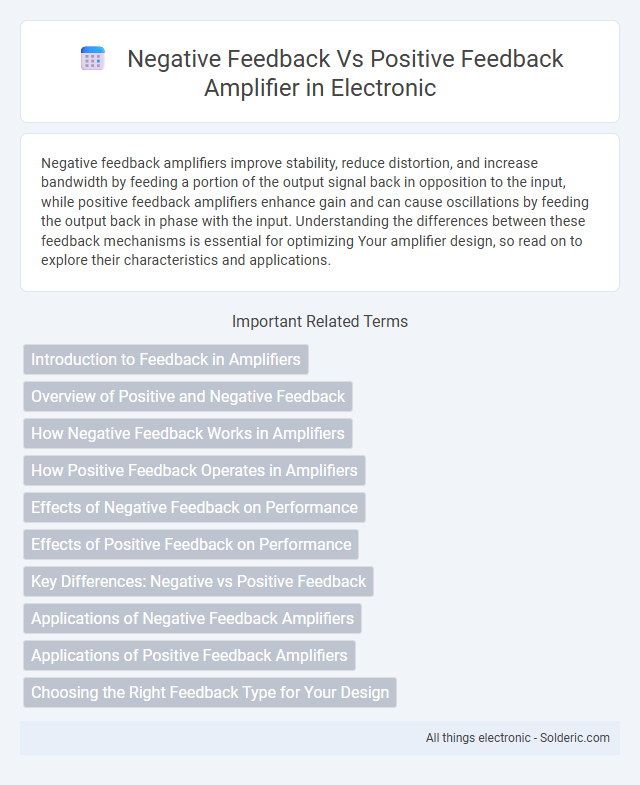Negative feedback amplifiers improve stability, reduce distortion, and increase bandwidth by feeding a portion of the output signal back in opposition to the input, while positive feedback amplifiers enhance gain and can cause oscillations by feeding the output back in phase with the input. Understanding the differences between these feedback mechanisms is essential for optimizing Your amplifier design, so read on to explore their characteristics and applications.
Comparison Table
| Feature | Negative Feedback Amplifier | Positive Feedback Amplifier |
|---|---|---|
| Feedback Type | Feedback signal opposes input | Feedback signal reinforces input |
| Gain Stability | Improves gain stability | Can cause gain to increase uncontrollably |
| Distortion | Reduces distortion | Increases distortion |
| Bandwidth | Increases bandwidth | Decreases bandwidth |
| Noise | Reduces noise | Can amplify noise |
| Stability | Enhances system stability | May cause instability or oscillation |
| Applications | Audio amplifiers, control systems | Oscillators, bistable circuits |
Introduction to Feedback in Amplifiers
Feedback in amplifiers involves routing a portion of the output signal back to the input to influence the overall gain and stability. Negative feedback subtracts a fraction of the output from the input, reducing distortion and improving bandwidth while enhancing linearity. Positive feedback adds output signal to the input, often leading to increased gain and potential oscillations, commonly used in oscillators and regenerative circuits.
Overview of Positive and Negative Feedback
Positive feedback amplifiers reinforce the input signal, increasing gain but potentially causing instability or oscillations; they are essential in oscillator circuits for sustained signal generation. Negative feedback amplifiers reduce gain by feeding a portion of the output back into the input in opposition to the original signal, enhancing stability, linearity, bandwidth, and reducing distortion. The choice between positive and negative feedback critically impacts amplifier performance, with negative feedback widely used in audio and control systems for improved fidelity and positive feedback employed in regenerative and oscillator applications.
How Negative Feedback Works in Amplifiers
Negative feedback in amplifiers works by feeding a portion of the output signal back to the input in an inverted form, reducing the overall gain but enhancing stability and linearity. This process minimizes distortion and improves bandwidth, ensuring your amplifier operates with consistent performance. By counteracting variations and noise, negative feedback maintains signal integrity and prevents unwanted oscillations.
How Positive Feedback Operates in Amplifiers
Positive feedback in amplifiers operates by feeding a portion of the output signal back to the input in phase, reinforcing the input signal and increasing the overall gain. This regenerative process can drive the amplifier into saturation or oscillation, often used in oscillator circuits or to create Schmitt triggers. You should note that unlike negative feedback, which stabilizes and linearizes amplifier response, positive feedback enhances signal amplitude but can reduce stability.
Effects of Negative Feedback on Performance
Negative feedback in amplifiers significantly improves stability, reduces distortion, and broadens bandwidth, making the output signal more faithful to the input. It lowers gain but enhances linearity, minimizes noise, and decreases sensitivity to component variations and temperature changes. In contrast, positive feedback increases gain but can lead to instability and potential oscillations.
Effects of Positive Feedback on Performance
Positive feedback in amplifiers enhances gain and can lead to oscillations by reinforcing the output signal, which increases the system's sensitivity to input variations. Your circuit may experience instability, higher distortion, and reduced bandwidth due to the regenerative effect of positive feedback. This performance impact contrasts with negative feedback, which stabilizes gain, reduces distortion, and increases bandwidth.
Key Differences: Negative vs Positive Feedback
Negative feedback amplifiers reduce gain to improve stability, bandwidth, and linearity while minimizing distortion and noise. Positive feedback amplifiers increase gain but risk instability and oscillations, often used in oscillator circuits. The key difference lies in feedback polarity: negative feedback opposes input signal changes, enhancing performance, whereas positive feedback reinforces input changes, potentially causing output saturation or oscillation.
Applications of Negative Feedback Amplifiers
Negative feedback amplifiers are widely used in audio systems to improve sound quality by reducing distortion and noise, enhancing signal stability and bandwidth. Precision measurement instruments rely on negative feedback to maintain accurate gain and minimize errors caused by component variations or temperature changes. In control systems, negative feedback amplifiers help achieve desired response characteristics by stabilizing the output and preventing oscillations.
Applications of Positive Feedback Amplifiers
Positive feedback amplifiers are widely used in oscillators, where they sustain continuous waveform generation by reinforcing the input signal. These amplifiers are essential in clock generation circuits, signal regeneration, and switching applications, providing high gain and stability for precise timing control. Your design benefits from positive feedback in devices such as Schmitt triggers and bistable multivibrators, which rely on hysteresis and rapid state transitions.
Choosing the Right Feedback Type for Your Design
Selecting the appropriate feedback type in amplifier design hinges on the desired outcome: negative feedback enhances stability, bandwidth, and linearity while reducing distortion and gain, making it ideal for precision applications. Positive feedback increases gain and sensitivity but risks oscillation and instability, which suits oscillator circuits or applications requiring regenerative amplification. Designers must evaluate the trade-offs between stability and gain to optimize performance for specific amplifier functions.
Negative feedback vs Positive feedback amplifier Infographic

 solderic.com
solderic.com